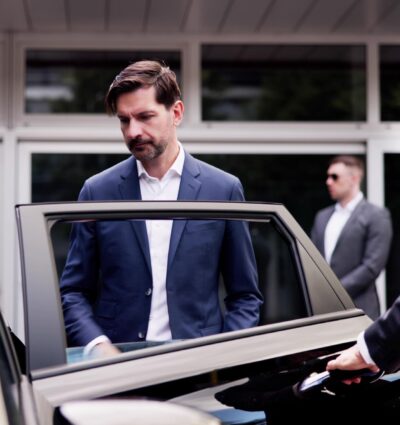
When we talk about security in executive transportation, people often think of guards, armored vehicles, or emergency protocols. However, in high-level corporate, institutional, and diplomatic environments, security begins long before the passenger gets into the vehicle.
Meticulous planning, advanced coordination, and the ability to anticipate risks are now indispensable elements in any executive mobility operation. In a context where trips may involve confidential agendas, complex environments, or last-minute changes, providing security doesn’t simply mean reacting to unforeseen events, it means anticipating them with precision.
Visible security vs. invisible security: what isn’t seen also matters
In executive transportation, the visible elements of security are easily recognizable: armored vehicles, armed guards, or real-time GPS tracking are important components, especially in high-risk environments.
However, another type of protection lies in the invisible elements of executive security: prevention and anticipation. This involves flawless logistical coordination, punctuality understood not just as a courtesy but as a protective measure, and the specialized training of drivers. A mistake in pick-up time, a poorly managed location, or a misinterpreted itinerary can compromise not only a schedule but also the overall safety of the traveler and their team.
The ability to anticipate, foresee scenarios, and minimize any margin of operational error is what truly ensures a safe, discreet, and efficient executive transfer.
Punctuality as a matter of security
A delay of just a few minutes can disrupt a diplomatic protocol, prevent access to a restricted area, or leave the passenger exposed in a location that hasn’t been previously vetted by the security team.
Tight schedules, last-minute changes, and high-profile events demand absolute precision. A transfer that doesn’t arrive on time can force improvisations that increase risk. The goal of a private transportation company is always to ensure punctuality and a secure pick-up point. Additionally, having the vehicle and driver information up to seven days in advance for the most common business destinations guarantees a reliable and controlled experience.
Security protocols and flexibility in executive transfers
This level of foresight allows transportation to be integrated into existing security protocols, especially in sensitive contexts such as diplomatic visits, institutional tours, or transfers of international artists. It is possible to coordinate the transportation service with executive bodyguards, restricted access points, authorized personnel, or entry into official venues.


In executive mobility, it is common to work with protocol and security teams, integrating each transfer into a broader framework of protection for the executive. This involves direct communication with those responsible for the executive’s movement, validation of alternative routes, secure pick-up points, and the driver’s early presence in the area.
Additionally, having drivers available by the hour allows adaptation to schedule changes without creating additional pressure. This flexibility not only provides peace of mind to the passenger but also eliminates potential friction points with the overall security of the environment.
How Drivania ensures comprehensive security during transfers
Security assurance is built on a combination of factors such as the driver, real-time communication, and integration with international protection protocols. At Drivania, we understand that our passengers trust more than just a ride; they trust a complete, flawless service.
Real-Time Communication
One of the keys to a secure transfer is eliminating improvisation. Using a booking platform with real-time updates allows assistants, agents, and security teams to:
- Know if the driver is en route, in position, or if the passenger has been picked up.
- Maintain open communication channels with the driver and the operational team, without relying on phone calls or manual confirmations.
- Make quick decisions in response to itinerary changes or environmental conditions, with full visibility of the service status.
This real-time connectivity reduces operational stress, ensures that all parties are informed, and reinforces complete control of the transfer from the first to the last minute.
The driver profile for a safe executive transportation
The driver is one of the cornerstones of any executive transfer. Drivania selects drivers not only for their driving experience but also for their ability to operate in sensitive environments, remaining calm and acting quickly and professionally in the face of unforeseen events.
Valuable qualifications include:
- Evasive driving, particularly useful in higher-risk destinations and cities with the worst traffic.
- Alternative route management and local knowledge, enabling last-minute changes without delays or errors.
- Security protocols and communication skills, ensuring the driver knows how to act in risky situations without compromising the passenger’s safety.
Integration with international security protocols
Regularly working with diplomatic agencies, multinational corporations, and private security teams has allowed Drivania to adapt processes to seamlessly integrate into the world’s most demanding security protocols.
From early driver assignment to the coordination of restricted access and institutional protection teams, the staff is trained to become an integral part of the client’s security system. This approach greatly facilitates the work of:
- Personal assistants and travel managers, who require certainty and traceability.
- Security teams that can prevalidate every point of the itinerary.
- Organizers of diplomatic events or international tours, where protocols are strict and nothing can be left to chance.
Understanding what proactive security is means recognizing that it is not an add-on but the cornerstone of any protection strategy. The ability to anticipate risks, eliminate blind spots, and maintain operational control is what enables a private transportation service to truly meet the standards required by high-level executives, institutional authorities, or diplomatic delegations, safeguarding their privacy, security, and peace of mind.

Frequently asked questions about corporate transportation security
What does a proactive security service include in an executive transfer?
A proactive security service in an executive transfer includes advanced planning, pre-validated information, alternative routes, real-time communication, and trained drivers. Everything is designed to anticipate risks, adapt to unforeseen events, and ensure uninterrupted security.
How does Drivania stand out in terms of security?
Drivania offers a comprehensive approach, combining technology, operational planning, and rigorous driver selection. The company integrates into international security protocols, provides information in advance, and offers real-time monitoring, reducing the margin for error.
Can a chauffeur service be integrated into diplomatic or corporate security protocols?
Yes. Drivania has experience collaborating with diplomatic security teams, government agencies, and global corporations. Also with coordinating access, following customized protocols, and adapting to each specific situation.
How are drivers trained for high-profile transfers?
Drivania drivers receive continuous training in defensive and evasive driving, safe route management, security protocols, and communication with operational teams. They are also selected for discretion, professionalism, and the ability to act under pressure without compromising passenger safety.
Can armored vehicles be requested at any destination?
In most major destinations, yes. Drivania maintains an international fleet of armored vehicles, and such transfers can be arranged upon prior request, especially in higher-risk areas or for transfers with special requirements.